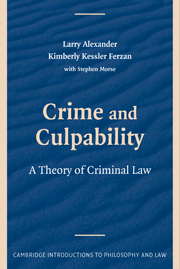3 - Negligence
Published online by Cambridge University Press: 05 June 2012
Summary
Unlike purpose and knowledge, negligence cannot be collapsed into recklessness. To be negligent, one does not advert to (in the sense of “be aware of”) the unreasonable risk that one is creating with respect either to the proscribed result or to the proscribed nature of one's conduct. It is adverting to such risks that converts one's negligent conduct into recklessness. True negligence is inadvertent creation of unreasonable risks. What distinguishes negligence from strict liability is that the negligent actor's unawareness of the risk is a failure to meet the objective “reasonable person” standard.
The Model Penal Code's definition of negligence is representative:
Negligently. A person acts negligently with respect to a material element of an offense when he should be aware of a substantial and unjustifiable risk that the material element exists or will result from his conduct. The risk must be of such a nature and degree that the actor's failure to perceive it, considering the nature and purpose of his conduct and the circumstances known to him, involves a gross deviation from the standard of care that a reasonable person would observe in the actor's situation.
Why Negligence Is Not Culpable
Essentially, those who deem negligence to be culpable argue that failure to advert to a risk that one had a fair chance to perceive (had one tried) is culpable, even though it does not entail a conscious choice to produce or to unreasonably risk harm.
- Type
- Chapter
- Information
- Crime and CulpabilityA Theory of Criminal Law, pp. 69 - 85Publisher: Cambridge University PressPrint publication year: 2009
- 2
- Cited by



